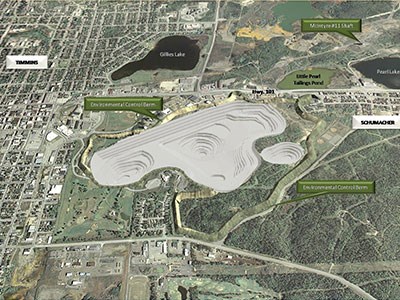Over the next five to eight years, the Hollinger Project will recover gold, rehabilitate a former underground mine property, and provide work for around 120 people. When the resource is depleted, the city will have the use of reclaimed land that includes green space and an extensive walking trail system.
Currently under development by Porcupine Gold Mines, a subsidiary of Goldcorp, the Hollinger Project is repurposing the former Hollinger underground gold mine, which produced 19,327,691 ounces of gold between 1910 and 1968, into an open-pit operation.
The decision to convert the mine was made after four years of deliberation about the future of the property. Decades of mining had left dangerous shaft openings, near-surface stopes, small pits, ground subsidences, and other dangerous hazards on the site, and the untended land was a blight on the city.
Mark Lauzier, general manager of Porcupine Gold Mines, said the company is taking a multi-pronged approach to the project.
“The initial intent of the project was to take a property that’s been dormant for 20 years or more — a fenced off property that no one could access and sort of an eyesore for Timmins — and rehabilitate this land and return it for safe public use, recover the gold to help us pay for the rehabilitation, and hopefully make a little bit of profit while we’re doing it as well,” he said.
Construction began early in 2014 with the stripping of overburden from the site and blasting to construct a berm, which will shield the city from the dust, noise and other hazards associated with mining activity.
The berm is now 40 per cent complete and most of the overburden has been stripped down, said Steve Price, manager for the Hollinger Project.
“Our current timeline is showing us having the berm complete by the end of Q1 next year, and also puts us at our elevation as per our permit that will allow us to move to 24-hour work,” he said. “At the moment, we’re working 7 a.m. to 7 p.m., and we’re allowed two blast windows in that day. That’s our self-imposed noise threshold we agreed to with the city.”
The average blast size is 25,000 tonnes. Activity will shift to mining ore for processing once the pit reaches two bench levels below ground elevation, Lauzier added.
Once mining begins in earnest, the company will require 60 new hires for the operation.
“We’re starting to hire some of those people now, but we don’t want to hire them too quickly,” Lauzier said. “We want to make sure we have enough time to train them, and we hire at a time that works out for the schedule.”
The project hasn’t been without its challenges. Heavy rainfall throughout the summer and fall have slowed its progress, and during blasting in July, a stray piece of rock landed in the Goldcorp parking lot. The company suspending blasting for six weeks, putting the project two and a half months behind schedule.
What followed was a thorough investigation to figure out what happened and, as a result, PGM changed some of its practices to prevent future similar incidents.
“We enlisted a couple of experts to help with it, and there’s always an opportunity to improve,” Price said. “So far, all of our blasts have gone exactly as we expected them to.”
A plan for land use following closure of the mine is simultaneously in the works. Following a series of public consultation sessions last winter, the company is now working with a landscape architect to put suggestions into a workable plan. That plan will go to corporate office for approval and then go to city council for its approval, said Trish Buttineau, PGM’s coordinator of communications and corporate social responsibility.
“Once the land is reclaimed and all elements that the community have asked for are incorporated into the plan, the land will be turned over back to the city of Timmins,” Buttineau said.
An extensive trail network is already one agreed-upon element of the land-use plan. An initial network will be built within two years of the berm’s completion, and it will be expanded once mining has finished.
“This is an important project for Goldcorp, and it’s important to get the community involved to ensure that they’re going to use the space after mining is completed,” Buttineau said.
To keep the community in the loop, PGM makes a quarterly report to council, which is streamed online, and noise data from the site is available on the Hollinger Project website.
“The whole intent of this project is to properly close off this land and return it to the community for safe public use to the best of our ability, and that’s still our goal,” he said.




